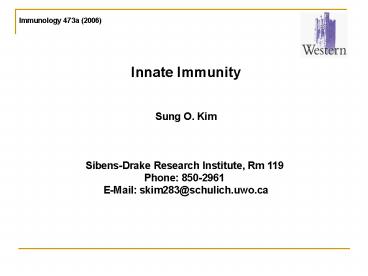Innate Immunity PowerPoint PPT Presentation
1 / 17
Title: Innate Immunity
1
Immunology 473a (2006)
Innate Immunity Sung O. Kim Sibens-Drake
Research Institute, Rm 119 Phone 850-2961
E-Mail skim283_at_schulich.uwo.ca
2
Topics 1. Overview (Innate immunity) From
plant to human 2. Complement system/Phagocytosis
3. Toll-like receptors I 4. Toll-like
receptors II and NOD like receptors 5.
Intracellular nucleic acid sensing (eg. RLHs) and
the interferon response Tutorial
- Reference book and articles
- Immunobiology (6th ED), Janeway, Chapter 2 and
15 - Review articles indicated in each section
- Lecture note (http//instruct.uwo.ca/microbiology
/473a/)
- Exam will be on the contents presented in lecture
slides
3
Metchnikoff, who identified phagocytes (first in
invertebrates Later in vertebrates) is often
considered the father of innate immunity.
Because innate defense mechanisms are
phylogenetically ancient, innate immunity is
often considered primitive immunity.
4
Beginning of Immunology cellular vs. humoral
immunity
Early 1900s
EIya Metchnikoff Pasteur Institute in Paris
Paul Ehrlich Berlin School
Nature review Mol. Cell. Biol. 4897 (2003)
5
Definition
Innate immunity is a complex heritable system of
defense that confers most resistance to microbes
or foreign objects
- Complex Many receptors, multiple signal
cascades and various outcomes. RAG mutations
wipe out adaptive immunity, but no single
mutation can kill innate immunity. - Heritable Innate immunity utilizes germ-line
encoded receptors, whereas adaptive immunity
utilizes somatically recombined receptors and
clonal selections. Also called natural
immunity or innate resistance. The genome of
the host will seize upon any mechanism it can to
defend itself. - Microbes Immunity against virus to parasites
- Foreign components Microbial components and
altered endogenous origins - Some of the genes that confer innate immunity
are dedicated others are multifunctional.
Example Toll (in Drosophila) also plays
important roles in development. TLRs are also
expressed in adaptive immune cells and regulate
their function.
6
- Innate immunity in Kingdom plantae (ref Lecture
note posted and review articles within)
- Plants are lacking adaptive immunity and
specialized innate immune cells - such as MF, neutrophils, and DC mostly at the
level of single cell - redundant layers of protective mechanisms
constitutive barriers such as wax layers, rigid
cell walls, anti-microbial enzymes, or secondary
metabolites - fast response to limit the area and restrict its
spreading via necrotic cell death (hypersensitive
response) pathogens do not have much chance to
obtain virulence factors
- Infections in plants are infrequent and usually
do not cause problems in general. However, it can
be a problem if monoculture settings such as in
agriculture, resulting in decrease of crops.
7
general
PLANTS IMMUNITY
Pathogen specific
Gene-for-gene immunity
8
Example of race-specifc elicitor (Avr) and
resistance (R) gene in tomato plants
- Pto gene
Pto gene
Symptoms of speck disease and resistance in
tomato leaves inoculated with P. syringae pv.
tomato
Microbes Infection (2000)21591
9
Examples general and gene-for-gene
(race-specific) elicitors and immunity receptors
in plants
10
- Plants effector systems
1. Hypersensitive responses
- react to pathogen within minutes, causing cell
death, cell wall fortification, callose
deposition, release antimicrobial agents (lytic
enzymes chitinase, glucanase, proteases,
defensins and phytoalexin etc) - Genes for the antibacterial and antifungal
molecules are called - pathogenesis-related gene (PR).
- At least 11 families PR genes have been
identified
11
The innate immunity in Kingdom animalia (Chapter
15, p665-681)
12
Cells of the innate immune system (Chapter 2,
p37-45, 89-95)
- Professional phagocytes
- Granulocytes neutrophils
- Agranulocytes monocytes/macrophages
- Dendritic cells (? Controversial)
- Primarily secretory cells Mast cells,
eosinophils and basophils lyctic enzymes, free
radicals,
- Lymphoid elements evolved to fulfill innate
rather than adaptive functions - NK cells (CD56 (NK1.1) CD3- cells)
- NKT cells (Va14-Ja18 TCR (Va14i) and NK1.1
cells) - B1 B cells
- ?d T cells
- Epithelial cells and almost every cell in body
---- the interferon response
13
- B1 B cells
- CD5, T cell independent IgM production
- High in peritoneum and lung cavities
- Recognize bacterial antigen phosphorylcholine
and self antigens DNA etc - ?d T cells
- ?d heterodimer TCR (limited pairing)
- localized in skin and intestinal tract
- function is not clear but may recognize blood
cancer cells and bacteria infected cells. - Produce type II IFN and tissue growth factors
- Natural killer T cells (NKT cells)
- CD56/NKR-P1C and express invariable TCR (Va14
in mouse or Va24 in humans) - Activated by CD1d bound a-galactosylceramide and
(bacterial) glycolipids - Produces cytokines and regulate other immune
cells - NK cells
- CD56 (human)/NKR-P1C(mouse), CD3- cells
- Peripheral blood (5-20 of lymphocytes), spleen
- Innate immune to protect against virus, bacteria
and tumors - Secretion of various cytokines, chemokines and
cell mediated cytotoxicity
14
Bone marrow hematopoietic stem cells
Lymphoid progenitor
Myeloid progenitor
Red blood cells (erythrocytes) platelets
(Polymorphonuclear cells)
Phagocytes
- 1.75 x 1011 erythrocytes/day
- 7 x 1010 leukocytes/day
- ½ cup of compacted neutrophils/day
15
Executors of innate immunity
- Antimicrobial polypeptides
- eg. Defensins produced by neutrophils,
- macrophages and mucosal epithelium
- and disrupt bacterial surface membranes
- Antimicrobial enzymes eg. lysozyme
- Reactive oxygen and NO species
- Complement
- Immune regulators chemokines and cytokines
- Cell autonomous process eg. Type I interferons
which can be produced by many somatic cells
Secretion of defensins by paneth cells within
intestinal crypts serves as a primary barrier to
bacterial infection. (Oullette at UC Irvine)
16
The temporal pattern of a developing immune
response
Minutes
Hours
Days/Weeks
17
- Summary
- Brief history of immunology Definition of innate
immunity - Plant immunity Key terms/definitions used in
plant immunology - Phylogenetics of immunity in animals beginning
of adaptive, TLRs - Innate immune cells in mammals cell types
- Temporal response of immune responses

